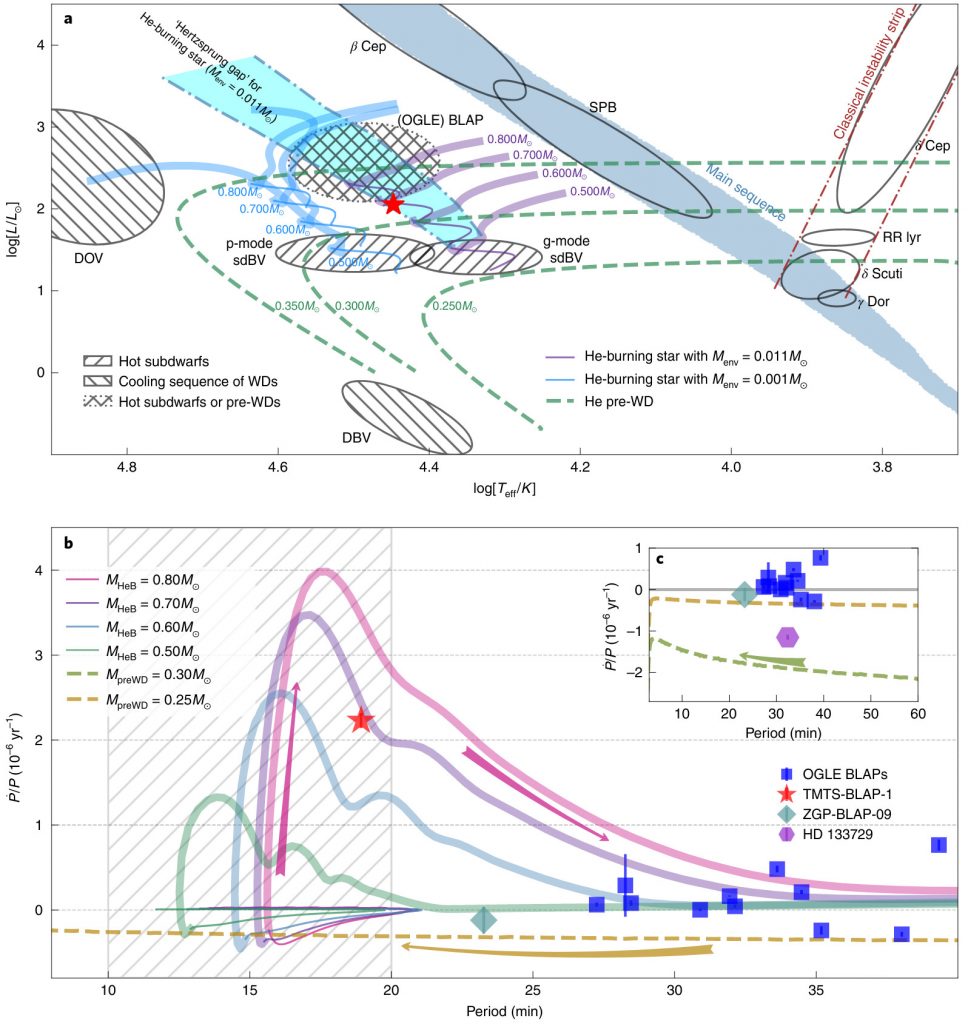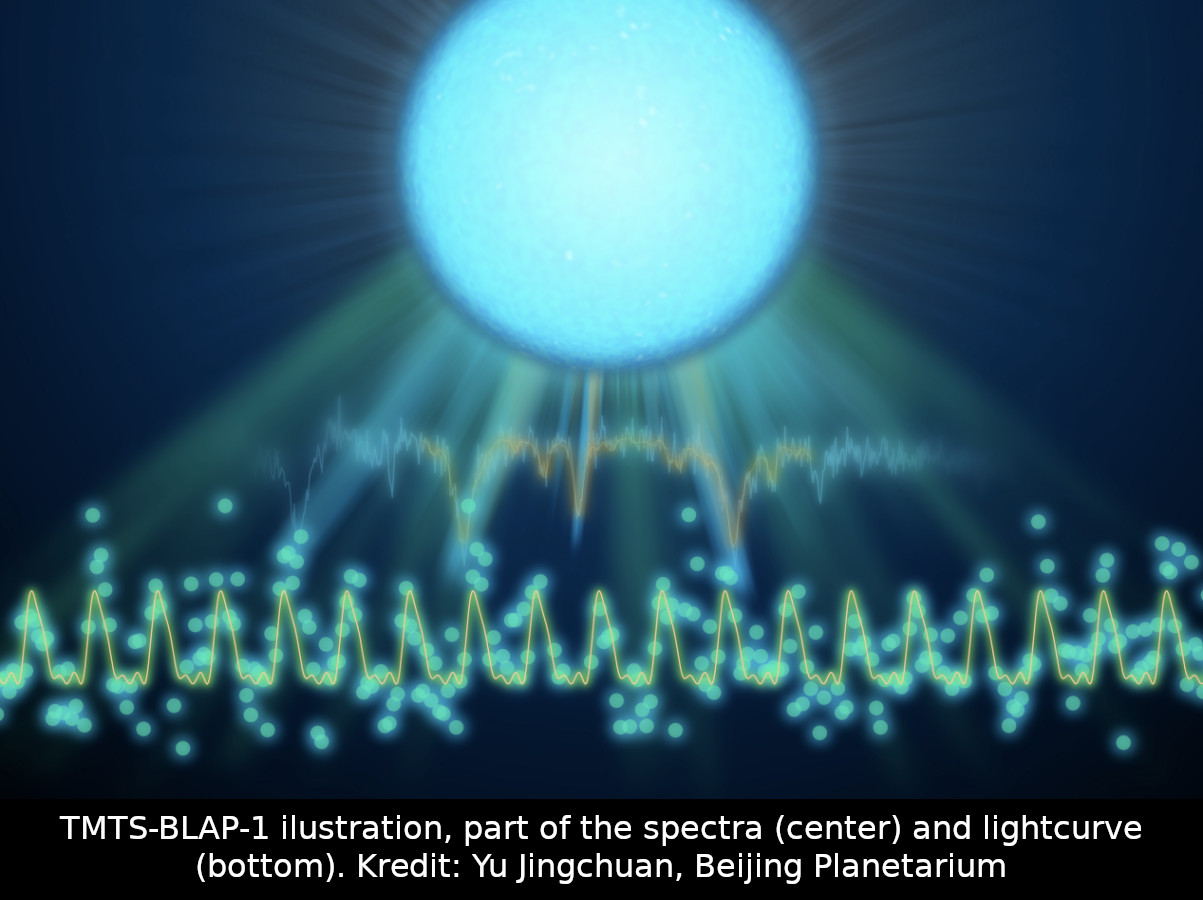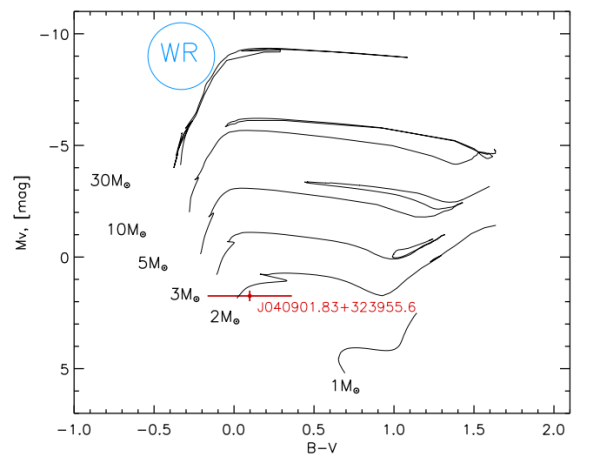The scientists of the Stellar Department of the Astronomical Institute of the Academy of Sciences of the Czech Republic have been researching various types of exotic variable stars for a long time. One of the interesting groups are blue large-amplitude pulsators, aka BLAP stars. Péter Németh from the Physics of Hot Stars working group participated in the study of the object designated TMTS-BLAP-1. He performed an analysis of spectra obtained with the 10-meter Keck telescope in Hawaii, which made it possible to determine the temperature, gravitational force on the surface and radial velocity of the star, and also its chemical composition. The team find out that TMTS-BLAP-1 is in a very rare evolution phase that could help scientists better understand the processes taking place inside stars. The work was published in the scientific journal Nature Astronomy. The research was supported by the Grant Agency of the Czech Republic.
Blue Large Amplitude Pulsators (BLAP) stars are a new type of variable stars. The first such star was discovered in 2017. They are evolved low-mass objects (less massive than our Sun) showing radial pulsations, meaning the stars expand and contract in a periodic way in about half an hour and have large amplitudes. These stars are assumed to be in a relatively short stage of their lives, evolving from the giant branch (in fact the horizontal branch) toward the white dwarf cooling sequence (in fact to the He shell burning subdwarf phase). Their inert and contracting CO core is releasing gravitational energy and the release of the energy is modulated by the thin atmosphere of the star, which causes the pulsations. Due to the fast evolution, BLAP stars are difficult to catch. They are very rare, only 14 are known, thanks to large sky surveys such as OGLE and LAMOST that observed billions of stars. The formation of BLAP stars is a mystery, some theories suggest that binarity plays a key role to form such a stripped star, while others suggest a merger of low-mass stars. TMTS-BLAP-1 is in a binary system.

The Hertzsprung-Russell diagram shows the possible evolution of the star TMTS-BLAP-1 (its current position in the diagram is marked by a red star) for three different candidate models with different parameters – solid purple line, solid light blue line, light green dashed line. The graph below shows the rate of change of the pulsation period for these development models. The best fit to the observations is a model in which a 0.70 M⊙ (Solar-mass) star burns helium in a 0.011 M⊙ envelope. Credit: Jie Lin et al.; Nature Astronomy
One can infer the physical properties of stars based on their light variations. Analogously how one can distinguish a church bell, a cowbell, and a sleigh tinkler based on the pitch of their sounds, astronomers can infer the sizes (and density) of stars from their pulsation periods. The newly found BLAP star TMTS-BLAP-1 changes its pulsation period very rapidly, indicating that the star is gradually expanding and its internal structure changes accordingly. The observed signature of the rapid evolution is that the 18.9-minute pulsation period of TMTS-BLAP-1 gets longer by 2.5 milliseconds every year! This rapid evolution gives unique insights into stellar evolution and will help improve our general understanding of stellar interiors. In particular so because TMTS-BLAP-1 is expanding rapidly, unlike all other BLAP stars that contract slowly from a giant phase to become a dwarf. This evolution was not unexpected, but not all theoretical models are able to explain it.
* The illustration in the introduction shows the TMTS-BLAP-1 system. A section of the spectrum (middle) and light curve (bottom) are shown. A BLAP star changes its brightness by 20% in less than half an hour (Credit: Yu Jingchuan).
More informations and contact
- scientific paper: An 18.9 min blue large-amplitude pulsator crossing the ‚Hertzsprung gap‘ of hot subdwarfs, Jie Lin et al.; Nature Astronomy, září 2022
- AI press release (in Czech)
- press release of Tsinghua University (Chinese)
- press contact: Pavel Suchan, Astronomical Institute AS CR: pavel.suchan@asu.cas.cz, 737 322 815
- contact: Dr. Péter Németh, Stellar department, Physics of Ho Stars working group (English): peter.nemeth@asu.cas.cz, pnemeth1981@gmail.com



